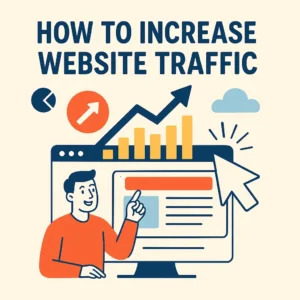How to Increase Website Traffic: A Proven 3-Stage Roadmap

Have you ever wondered why some websites easily attract millions of visitors every month while others struggle to get noticed? The secret isn’t random tips or quick “hacks”, it’s a proven 3-stage roadmap that makes traffic generation predictable.
Think of it like this: you might learn a few chords to play a simple song on guitar. But to master a complex piece, you need a structured approach, understanding theory, practicing scales, and honing techniques. Building significant website traffic is the same: you need a strategic foundation, not just quick fixes.
Stage 1: Adopt a Repeatable Strategy
The first step is to establish a strong foundation by deciding on the type of content you’ll create and the primary traffic sources you’ll target.
Some people chase viral content that can bring sudden bursts of traffic from social media or paid ads. However, this traffic often vanishes as quickly as it came.
For long-term growth, a more sustainable approach involves creating evergreen content and focusing on Search Engine Optimization (SEO). While SEO-driven traffic isn’t “instant,” it’s free, consistent, and compounds over time. Creating valuable, enduring content that’s discoverable in search helps you build a steady stream of visitors, moving you closer to milestones like 10,000 monthly visits. By consistently delivering useful information, you demonstrate expertise and trustworthiness.
Stage 2: Focus on the Tactics (The SEO Puzzle)
Once you’re committed to an SEO-centered strategy, it’s time to put specific tactics in place. If your site is below 10,000 monthly visits, focus on solving four essential pieces of the SEO puzzle. Mastering these builds authority and showcases your expertise.
Piece 1: Keyword Research
Determine the subjects and terms that individuals are using when they search online.
Start by brainstorming broad keywords in your niche. For example, if your site is about learning guitar, start with terms like “guitar,” “fingerpicking,” or “strumming.” Use keyword research tools to expand this list.
Next, use a three-point checklist to refine your list:
- Search Demand: Use keyword tools to ensure your chosen terms have consistent monthly searches.
- Realistic Ranking Chance: Target keywords where websites similar to yours are already ranking. Tools can help measure your site’s authority and set a realistic upper limit (like your site’s authority plus 10). By concentrating on attainable keywords, you may increase your visibility and authority.
- Business Value: Ensure the keywords you choose are relevant to your product or service. For a guitar education site, “how to play f chord on guitar” or “how much are guitar lessons” have high business relevance. Skip high-volume keywords that don’t align with your business goals.
Save the keywords that meet these criteria, these are your targets.
Piece 2: Match Searcher Intent
Search engines want to show the most relevant content for each query. Your goal is to match the searcher’s intent—understand what they want and deliver it quickly.
If someone searches “how much do guitar lessons cost,” they want prices right away. To truly stand out and demonstrate expertise, cover related questions too: what influences lesson costs, how to find a good teacher, and what to expect from lessons. Addressing these subtopics creates comprehensive content that builds trust and positions you as an authority.
Piece 3: Backlinks
Historically, one of the most powerful ranking indicators has been backlinks, or links pointing to your website from other websites. If you’re not getting much traffic, a lack of backlinks is likely a major reason.
Start by earning links to your homepage:
- Podcast Guesting: Appearing on relevant podcasts often results in a link from the episode page.
- Listicle Mentions: Get your site included in “best of” lists in your niche.
- Competitor Analysis: Use tools to find sites linking to competitors and target them for similar opportunities.
Beyond your homepage, you’ll also need backlinks directly to the specific pages you want to rank. These can be harder to earn but are crucial for boosting a page’s authority.
Piece 4: Site Structure
Internal links, links between your own pages are vital for SEO. They help search engines and users navigate your content.
Internal links are the only type of backlink you fully control. From an SEO standpoint, they’re powerful because authority from external backlinks can be passed along to other internal pages. For example, a high-authority “Guitar Chords” page can link to deeper pages like “how to play A chord” or “B chord,” helping them rank better. A thoughtful internal linking structure not only improves search performance but also makes it easier for visitors to find related information, reinforcing your expertise.
By consistently applying these SEO principles, you can realistically reach 10,000 monthly visits and beyond.
Stage 3: Diversify Your Traffic Sources
While SEO can drive consistent, compounding traffic, relying solely on one channel is risky. Algorithms and platform policies change, sometimes overnight.
Once SEO is delivering steady visitors, test additional traffic sources to build resilience. Keep two factors in mind:
- Audience Location: Make sure your audience spends time on the new platform.
- Effort vs. Reward: Look for platforms where the potential payoff justifies the effort.
An advantage of focusing on SEO first is that you likely already have high-quality content ready to repurpose. A detailed blog post can be adapted for a social media thread, turned into a video script, or adjusted for different formats and platforms.
Experiment to find what resonates on each platform. Once you find effective channels, double down on them, while continuing to build your SEO foundation. This diversification makes your traffic more robust and expands your reach.
By following this 3-stage roadmap, building a strong SEO foundation, mastering the four key SEO pieces, and thoughtfully diversifying, you’ll create a predictable, scalable system for significantly increasing your website traffic. If you’re looking for the best freelance digital marketing expert in Calicut to help you implement these strategies and grow your traffic even faster, feel free to reach out for a consultation today!